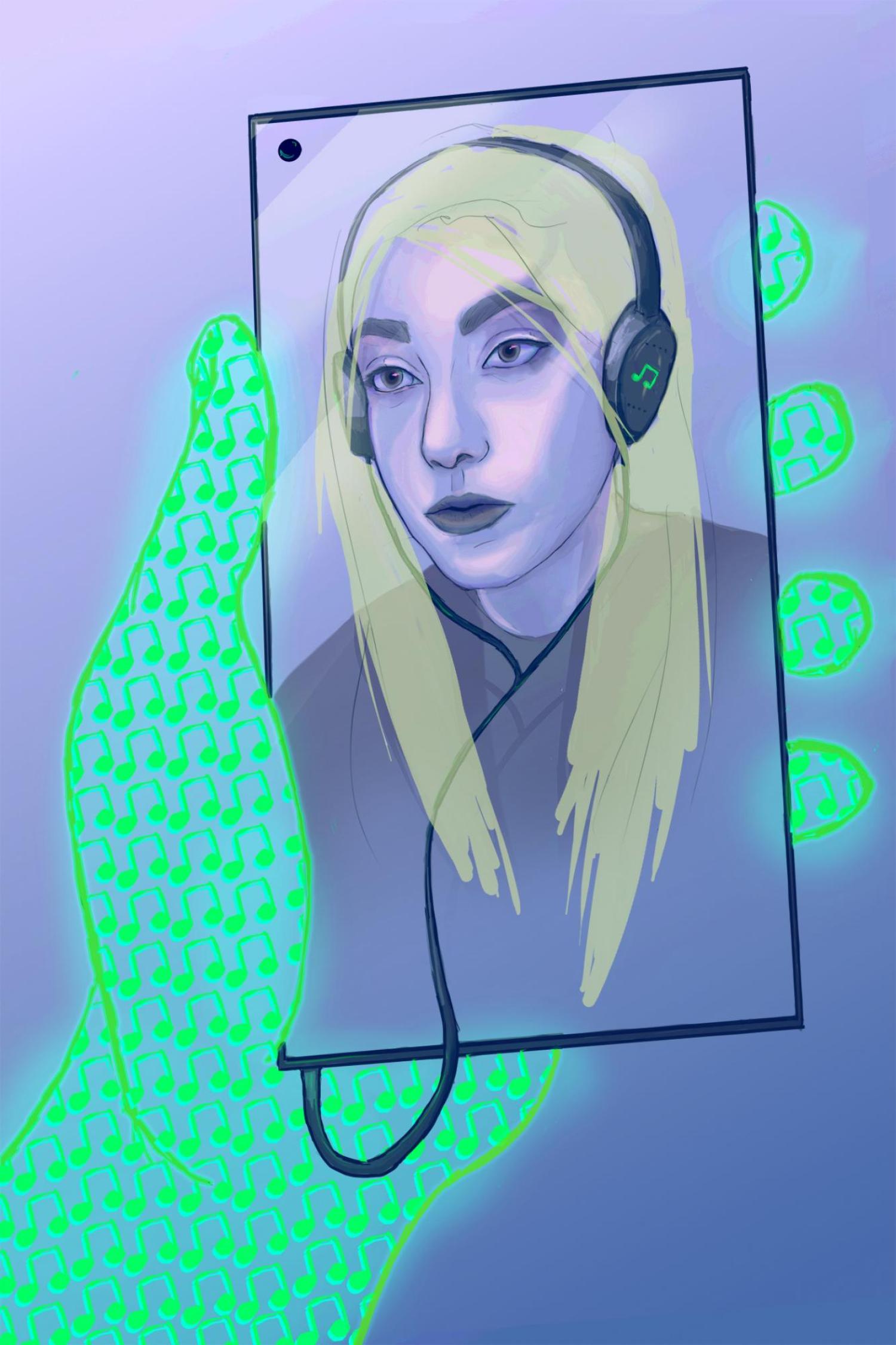Your Own Song: Short Version
By Ellie Haberl; Illustrated by Stuart Sachs

Kylie turned up the sound on her smart speaker, Eliza, and started to sing along with the music, a new release from her favorite singer, Saylor June.
Eliza was like a member of the family, especially since she was in charge of recommending music, and Kylie’s family loved listening to music together. Kylie’s parents valued independence and programmed Eliza to listen for Kylie’s voice from the time she was very young. The speaker used baby Kylie’s cries and coos to determine if she liked a song. Little by little, an algorithm was built around Kylie’s preferences as Eliza started to “learn” to play songs that Kylie liked. One day, Eliza played one of Saylor’s songs. When Kylie showed that she loved Saylor by clapping and singing along, the speaker learned to play Saylor more frequently.
Kylie’s parents were incredibly unique and original artists. Her dad was famous for creating his own method for mixing paint right on the canvas, and he and Kylie often painted together in his studio.
One night, Kylie brought the family’s smart speaker into the art studio and asked Eliza to play a mix she knew her dad enjoyed, singers who have inspired Saylor June. Eliza answered Kylie’s request in a chirpy voice, “Playing Saylor June inspiration. Enjoy.” A song by Andie, an artist who was popular in the 80’s started to play through the speaker.
“Oh, I LOVE this song! ” Kylie’s dad said as he held his paintbrush like a microphone and sang in a high screechy voice.
Kylie groaned, “Daaaaaad. C’mon! I love this song, too! I can’t even hear it over your terrible singing!” She took a piece of scratch paper, crumpled it into a ball and threw it at him.
“Listen up, pumpkin. You cannot silence me! I’ve loved this song longer than you’ve been alive. In fact, this song was playing the first time I went on a date with your mom!”
Kylie was surprised; she thought she had heard the story of how her parents met and 80s pop star Andie was never a part of the story. She was confused. “Wait, I thought you met online? What do you mean this song was playing?”
Kylie’s dad put down his paintbrush microphone and squirted a blob of paint onto his canvas. “Well, we met on this dating app called InTune that put people together based on their musical preferences. When we finally met, we weren’t surprised to learn that we both loved the singer Andie, so we sat outside under the stars and listened to Andie for hours.”
Kylie swirled the paint on her canvas, “Dad. That’s nuts!
It’s strange though, you mostly chose the recommendations from Eliza! And Eliza just kept on playing Saylor June’s music.”
Kylie froze in place. “Dad. This is bananas. Here I was thinking you were the coolest parents in the world because you let me pretty much listen to what I wanted, but you and mom fixed all my algorithms before I was old enough to choose! You played Andie when I was little, and I bet the smart speaker heard me enjoying the music and started to recommend other singers like Andie! I bet that’s why Eliza began recommending songs by Saylor; she sounds so similar to Andie! And the rest is history. It was all decided before I was born!”
Her dad put down the paintbrush and turned to face Kylie. “Sweetheart, don’t feel bad! It wasn’t Eliza’s music algorithm that made you who you are. Not at all.” He laughed. “It was the algorithm that brought your parents together and that made you who you are, or at least, partly who you are! He looked out the window and saw Kylie’s mom pull up in the driveway. He dropped his paintbrush in the water. “Oh! I’ll be right back, I’m going to help your mom carry in those canvases!” He rushed outside.
Kylie wasn’t sure how she felt about this new realization. There was just no way to find the boundary between who she was, authentically, and who she had become because of the presence of artificial intelligence in her childhood.
Kylie smiled. “Ah, well.” She thought, as she watched her parents help each other outside, “Maybe those algorithm wizards really know what they're doing.” She started to hum a Saylor song as she splashed paint onto her canvas.
Word count: 750
Developed by AI Ethics Project 2020. This work is licensed under a Creative Commons Attribution 4.0 International License.
Citation: Haberl, E. (2020). Your Own Song. V.1.0. Illustrated by S. Sachs. In B.Dalton and T. Yeh (Eds.), AI Stories Series. Available INSERT URL.
Acknowledgement: This work is supported by National Science Foundation Stem+C Award #1934151 to T. Yeh, S. Forsyth and B. Dalton, University of Colorado Boulder.

